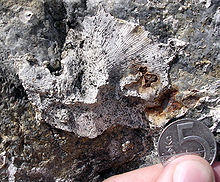Gorgonian
| Gorgonian | |
|---|---|

| |
| Iciligorgia schrammi | |
| Scientific classification | |
| Kingdom: | |
| Phylum: | |
| Class: | |
| Subclass: | |
| Order: | Gorgonacea Lamouroux, 1816
|
| Suborders and families | |
A gorgonian, also known as sea whip or sea fan, is an order of sessile colonial cnidarian found throughout the oceans of the world, especially in the tropics and subtropics. Gorgonians are similar to the sea pen, another soft coral. Individual tiny polyps form a colonies that are normally erect, flattened, branching, and reminiscent of a fan. Others may be whiplike, bushy, or even encrusting.[1] A colony can be several feet high and across but only a few inches thick. They may be brightly coloured, often purple, red, or yellow. Photosynthetic gorgonians can be successfully kept in captive reef aquariums[2].
Anatomy
The structure of a gorgonian colony varies. The suborder Holaxonia skeletons are formed from a flexible, horny substance called gorgonin. The suborder Scleraxonia variety of gorgonians are supported by a skeleton of tightly grouped calcareous spicules. There are also species which encrust like coral.[3] Most of holaxonia and sclerazonia, however, do not attach themselves to a hard substrate. Instead, they anchor themselves in mud or sand.
Research has shown that measurements of the gorgonin and calcite within several long-lived species of gorgonians can be useful in paleoclimatology and paleoceanography, as the skeletal growth rate and composition of these species is highly correlated with seasonal and climatic variation.[4][5][6]
Ecology

Each gorgonian polyp has eight tentacles which catch plankton and particulate matter that is consumed. This process, called filter feeding, is facilitated when the "fan" is oriented across the prevailing current to maximise water throughput and hence food supply.
Some gorgonians contain algae, or zooxanthellae. This symbiotic relationship assists in giving the gorgonian nutrition via photosynthesis. Gorgonians possessing zooxanthellae are usually characterized by brownish polyps. Those without zooxanthellae usually have more brightly colored polyps. Lacking this additional nutrition, they are more dependent on the nutrition they derive from filter feeding.[citation needed]
Gorgonians are found primarily in shallow waters, though some have been found at depths of several thousand feet.[1][3] The size, shape, and appearance of the gorgonians are highly correlated with their location. The more fan-shaped and flexible gorgonians tend to populate shallower areas with strong currents, while the taller, thinner, and stiffer gorgonians can be found in deeper, calmer waters.[1]
Other fauna, such as hydrozoa, bryozoa, and brittle stars, are known to dwell within the branches of gorgonian colonies.[7] The Pygmy seahorse not only makes certain species of gorgonians its home, but closely resembles its host and is thus well camoflauged. [8]
Gorgonians are classified in the phylum Cnidaria, class Anthozoa, alongside the orders Alcyonacea (soft corals) and Pennatulacea (sea pens). There are about 500 different species of gorgonians found in the oceans of the world, primarily in the shallow waters of the Atlantic near Florida, Bermuda, and the West Indies.[9]

References
- ^ a b c Borneman, Eric H. (2001). Aquarium Corals: Selection, Husbandry, and Natural History. Neptune City, NJ 07753: T.F.H. Publications. p. 464. ISBN 1-890087-47-5.
{{cite book}}: CS1 maint: location (link) - ^ "Photosynthetic gorgonian FAQs". AquaDaily. Retrieved 2009-01-31.
- ^ a b Goldstein, Robert J. (1997). Marine Reef Aquarium Handbook. Barron's Educational Series, Inc. p. 198. ISBN 0-8120-9598-7.
- ^ Heikoop, J.M. (2002-03). "Potential climate signals from the deep-sea gorgonian coral Primnoa resedaeformis". Hydrobiologia. 471 (1–3): 117–124. doi:10.1023/A:1016505421115.
{{cite journal}}: Check date values in:|date=(help); Unknown parameter|coauthors=ignored (|author=suggested) (help) - ^ Sherwood, Owen A. (2005). Cold-Water Corals and Ecosystems. Erlangen Earth Conference Series. Springer Berlin Heidelberg. pp. 1061–1079. doi:10.1007/3-540-27673-4. ISBN 978-3-540-24136-2.
{{cite book}}: Unknown parameter|coauthors=ignored (|author=suggested) (help) - ^ Bond, Zoë A. (2005-08-31). "Growth and composition of high-Mg calcite in the skeleton of a Bermudian gorgonian (Plexaurella dichotoma): Potential for paleothermometry". GEOCHEMISTRY GEOPHYSICS GEOSYSTEMS. 6: Q08010. doi:10.1029/2005GC000911.
{{cite journal}}: Unknown parameter|coauthors=ignored (|author=suggested) (help) - ^ Haywood, Martyn (1989). The Manual of Marine Invertebrates. Morris Plains, NJ: Tetra Press:Salamander Books Ltd. p. 208. ISBN 3-89356-033-5.
{{cite book}}: Unknown parameter|coauthors=ignored (|author=suggested) (help) - ^ Agbayani, Eli (2007-06-05). ""Hippocampus bargibanti, Pygmy seahorse"". FishBase. Retrieved 2007-09-22.
- ^ "Sea Fan". University of Delaware Graduate College of Marine Studies. Retrieved 2007-09-23.
- Sprung & Delbeek (1997), The Reef Aquarium, p. 31-32
